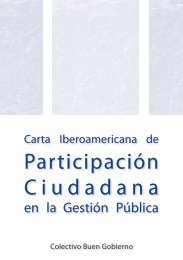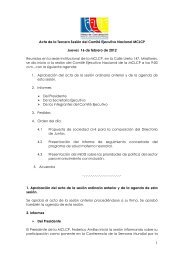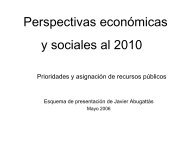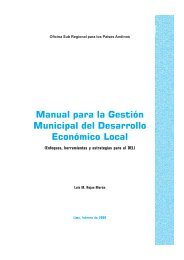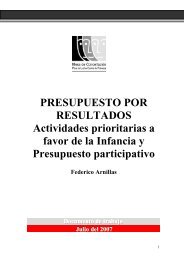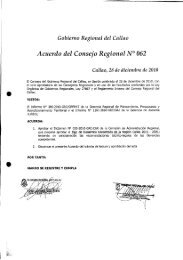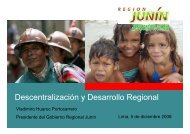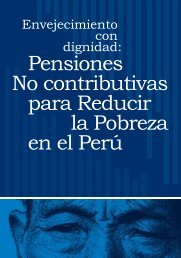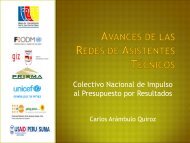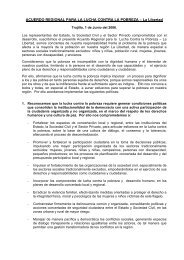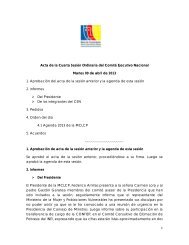Plan Estratégico de Desarrollo Regional Concertado Cusco al 2012
Plan Estratégico de Desarrollo Regional Concertado Cusco al 2012
Plan Estratégico de Desarrollo Regional Concertado Cusco al 2012
You also want an ePaper? Increase the reach of your titles
YUMPU automatically turns print PDFs into web optimized ePapers that Google loves.
<strong>Plan</strong> <strong>Estratégico</strong> <strong>de</strong> <strong>Desarrollo</strong> <strong>Region<strong>al</strong></strong> <strong>Concertado</strong> <strong>Cusco</strong> <strong>al</strong> <strong>2012</strong><br />
‣ Festiv<strong>al</strong> nacion<strong>al</strong> <strong>de</strong> camélidos <strong>al</strong>toandinos <strong>de</strong><br />
Espinar.<br />
‣ Festiv<strong>al</strong> region<strong>al</strong> <strong>de</strong> camélidos sudamericanos<br />
<strong>de</strong> Phinaya.<br />
‣ Festiv<strong>al</strong> <strong>de</strong> camélidos sudamericanos <strong>de</strong><br />
Chumbivilcas.<br />
‣ Festiv<strong>al</strong> <strong>de</strong> camélidos sudamericanos <strong>de</strong><br />
Ocongate.<br />
‣ Ferias <strong>de</strong> camélidos: Condoroma, Chañi,<br />
Huaraconi, Patac<strong>al</strong>asaya, Chillihua, S<strong>al</strong>lani.<br />
Los productores están organizados en todas<br />
las provincias productoras <strong>de</strong> camélidos y también<br />
tienen organizaciones <strong>de</strong> carácter region<strong>al</strong>. En el<br />
presente año se re<strong>al</strong>izó el 2do. Congreso <strong>de</strong><br />
Productores <strong>de</strong> Alpacas y Llamas <strong>de</strong> la región<br />
<strong>Cusco</strong>, lo que ha servido para consolidar su sector<br />
(ver Cuadro Nº 39).<br />
La existencia <strong>de</strong> todas las varieda<strong>de</strong>s <strong>de</strong><br />
<strong>al</strong>pacas (Wakaya, Suri), con 21 colores natur<strong>al</strong>es<br />
i<strong>de</strong>ntificados y llamas (Qara, Ch’aku) en distintos<br />
colores, así como la existencia <strong>de</strong> anim<strong>al</strong>es <strong>de</strong><br />
c<strong>al</strong>idad cuya finura ha sido res<strong>al</strong>tada en los<br />
Festiv<strong>al</strong>es Internacion<strong>al</strong>es, <strong>de</strong>termina que los<br />
camélidos sudamericanos en la región <strong>Cusco</strong><br />
constituyan un importante recurso genético que<br />
pue<strong>de</strong> ser aprovechado en beneficio <strong>de</strong>l <strong>de</strong>sarrollo<br />
<strong>de</strong> nuestro país.<br />
En la región <strong>Cusco</strong> se han i<strong>de</strong>ntificado<br />
ecotipos loc<strong>al</strong>es <strong>de</strong> llamas con colores y conformación<br />
que las hace distintas a las existentes en otras<br />
regiones, así como vicuñas <strong>de</strong> mecha larga cuyo<br />
tipo sólo estaría ubicado en el <strong>Cusco</strong>.<br />
La fibra <strong>de</strong> los camélidos sudamericanos está<br />
entre las más apreciadas por la industria textil que<br />
utiliza fibras anim<strong>al</strong>es como materia prima, y compiten<br />
con el Cashemire, Mohair y la Angora. Entre<br />
las fibras <strong>de</strong> camélidos la <strong>de</strong> <strong>al</strong>paca es la que<br />
tiene más aceptación mundi<strong>al</strong> <strong>de</strong>bido a su c<strong>al</strong>idad<br />
y cantidad. La fibra <strong>de</strong> <strong>al</strong>paca representa el 10% <strong>de</strong><br />
la producción mundi<strong>al</strong> <strong>de</strong> fibras finas <strong>de</strong> origen anim<strong>al</strong>.<br />
En el comercio internacion<strong>al</strong> <strong>de</strong> fibras finas,<br />
la <strong>al</strong>paca apenas representa el 3% (lo que nos <strong>de</strong>muestra<br />
el gran mercado potenci<strong>al</strong> que existe para<br />
este producto en el mundo). A pesar <strong>de</strong> ser el Perú<br />
el primer productor <strong>de</strong> fibra <strong>de</strong> <strong>al</strong>paca en el mundo,<br />
ya que produce el 80% <strong>de</strong> la producción mundi<strong>al</strong>,<br />
preocupa que otros países como EE.UU., Canadá,<br />
Nueva Zelandia, Francia, Austr<strong>al</strong>ia e Inglaterra,<br />
estén reproduciendo una gran cantidad <strong>de</strong><br />
<strong>al</strong>pacas; es así como Austr<strong>al</strong>ia posee 35,000 <strong>al</strong>pacas<br />
y EE.UU. posee 26,000 anim<strong>al</strong>es, muchos <strong>de</strong> ellos<br />
<strong>de</strong> muy buena c<strong>al</strong>idad, que fueron importados <strong>de</strong><br />
Sudamérica, especi<strong>al</strong>mente <strong>de</strong>l Perú. En estos países<br />
se está haciendo una inversión consi<strong>de</strong>rable y<br />
recurriendo a toda la tecnología existente para<br />
Cuadro Nº 39<br />
CUSCO: POBLACIÓN DE ALPACAS Y LLAMAS<br />
PROVINCIA ALPACAS LLAMAS<br />
TOTAL SURI WAKAYA TOTAL CH’AKU QARA<br />
C<strong>al</strong>ca 8,108 2,612 5,496 12,448 4,775 7,673<br />
Canas 18,478 1,850 16,628 16,057 6,591 9,466<br />
Acomayo 7,785 2,085 5,700 8,998 4,244 4,754<br />
Anta 272 105 167 1,446 470 976<br />
Canchis 138,339 10,717 127,622 22,354 12,398 9,956<br />
Chumbivilcas 31,031 6,829 24,202 24,217 14,933 9,248<br />
Espinar 62,104 4,552 57,552 48,756 18,707 30,049<br />
La Convención 275 45 230 178 106 72<br />
<strong>Cusco</strong> 92 14 78 2,923 972 1,951<br />
Quispicanchi 68,967 9,184 59,783 20,643 9,071 11,572<br />
Urubamba 4,930 1,588 3,342 6,851 3,397 3,454<br />
Paruro 175 129 46 2,197 1,574 623<br />
Paucartambo 5,244 1,666 3,578 10,932 2,384 8,548<br />
TOTAL 345,800 41,376 304,424 178,000 79,622 98,378<br />
FUENTE: Elaboración CTAR-<strong>Cusco</strong> 1996.<br />
- 78 -



